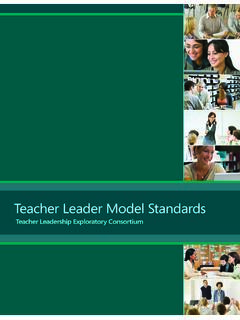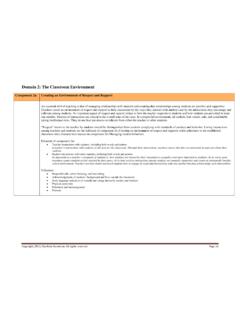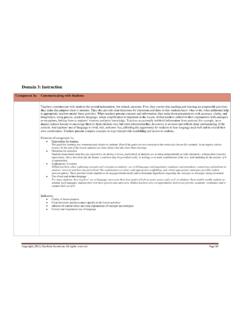Transcription of Charlotte Danielson’s FRAMEWORK FOR TEACHING
1 Charlotte danielson s FRAMEWORK FOR TEACHINGDOMAIN 1: Planning and Preparation1a Demonstrating Knowledge of Content and Pedagogy Content knowledge Prerequisite relationships Content pedagogy1b Demonstrating Knowledge of Students Child development Learning process Special needs Student skills, knowledge, and proficiency Interests and cultural heritage1c Setting Instructional Outcomes Value, sequence, and alignment Clarity Balance Suitability for diverse learners1d Demonstrating Knowledge of Resources For classroom To extend content knowledge For students1e Designing Coherent Instruction Learning activities Instructional materials and resources Instructional groups Lesson and unit structure1f Designing Student Assessments Congruence with outcomes Criteria and standards Formative assessments Use for planningDOMAIN 4.
2 Professional Responsibilities4a Reflecting on TEACHING Accuracy Use in future teaching4b Maintaining Accurate Records Student completion of assignments Student progress in learning Non-instructional records4c Communicating with Families About instructional program About individual students Engagement of families in instructional program4d Participating in a Professional Community Relationships with colleagues Participation in school projects Involvement in culture of professional inquiry Service to school4e Growing and Developing Professionally Enhancement of content knowledge and pedagogical skill Receptivity to feedback from colleagues Service to the profession4f Showing Professionalism Integrity/ethical conduct Service to students Advocacy Decision-making Compliance with school/district regulationsDOMAIN 2.
3 The Classroom Environment2a Creating an Environment of Respect and Rapport Teacher interaction with students Student interaction with students2b Establishing a Culture for Learning Importance of content Expectations for learning and achievement Student pride in work2c Managing Classroom Procedures Instructional groups Transitions Materials and supplies Non-instructional duties Supervision of volunteers and paraprofessionals2d Managing Student Behavior Expectations Monitoring behavior Response to misbehavior2e Organizing Physical Space Safety and accessibility Arrangement of furniture and resourcesDOMAIN 3: Instruction3a Communicating With Students Expectations for learning Directions and procedures Explanations of content Use of oral and written language3b Using Questioning and Discussion Techniques Quality of questions Discussion techniques Student participation3c Engaging Students in Learning Activities and assignments Student groups Instructional materials and resources Structure and pacing3d Using Assessment in Instruction Assessment criteria Monitoring of student learning Feedback to students Student self-assessment and monitoring3e Demonstrating Flexibility and Responsiveness Lesson adjustment Response to students communicates that the listener
4 HEARD what the speaker said BUT doesNOT fully UNDERSTAND what was involves ASKING A QUESTION (direct or implied) to:1. Gather more information2. Discover the meaning of the language used3. Get clarity about the speaker s reasoning4. Seek connections between ideas5. Develop or maintain a focusSome possible clarifying stems include thefollowing:Say a little more you clarify what you mean by ..?Share an example of ..So, are you what ways is that idea like (or different from) ..?When you say _____, what meaning doesthat have for you?NON JUDGMENTAL RESPONSESB uild trustPromote an internal locus of controlEncourage self-assessmentDevelop autonomy Foster risk-takingPossible examples:Identify what worked and whyWhen you_____ the student really_____EncourageIt sounds like you have a number of ideas to tryout!
5 It ll be exciting/interesting/great to seewhich works best for you!Ask the teacher to self-assessHow do you think the lesson went and why?PARAPHRASINGP araphrasing communicates that the listener what the speaker said,UNDERSTOOD what was said, and CARESP araphrasing involves either:RESTATING in your own words, or SUMMARIZINGSome possible paraphrasing stems includethe following:So ..In other words ..You are saying ..You are feeling ..Your opinion is ..You re considering several things ..A value or belief you have ..MEDIATIONAL QUESTIONSHYPOTHESIZE what might happenANALYZE what worked and what didn tIMAGINE possibilitiesCOMPARE AND CONTRAST what wasplanned with what happened: What might be some other ways.
6 ?What would it look like if ..?What might happen if you ..?What do you consider when you decide ..?INSTRUCTIONAL STEMSWhat we know research around this shows couple of things to keep in teachers have are number of it s helpful STEMSOne thing we ve learned/noticed couple of things to keep in teachers have tried a couple of dif-ferent things in this sort of situation andmaybe one might work for effective teachers seem to know about_____ is _____ ..Something/some things to keep in mind whendealing you might consider trying are a number of it s helpful following a suggestion with a question that invites the teacher toimagine/hypothesize how the idea mightwork in his/her might that look in your classroom?
7 To what extent might that be effective in your situation/with your students?What do you imagine might happen if you wereto try _____ with your class?Which of these ideas might work best in yourclassroom (with your students)?




